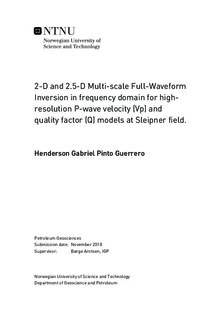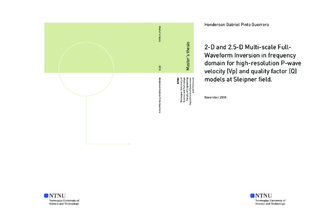| dc.description.abstract | In this work, we have applied a multi-scale discretized Full-Waveform Inversion in frequency-space domain considering both the 2-D and 3-D viscoacoustic wave equation for deriving P-wave velocity (Vp) and quality factor (Q) models in two inlines extracted from two vintages of the Sleipner Field (1994 and 2008).
The algorithm uses the waveform information from the pre-stack datasets of the Sleipner field recorded in 1994 and 2008 (before and after the injection of had CO\textsubscript{2} started). A pre-processing workflow, aiming to enhance the signal to noise ratio (S/N) without harming the amplitudes, is applied to the data before the application of the FWI method.
In a first stage, several tests were performed on synthetic data, aiming to measure the sensitivity of the algorithm when it comes to handle noisy sources, a less reliable initial model and different spacing grids. From these test, it was found that the algorithm is quite sensitive to handle noise in the sources, having converged to a local minimum when a S/N ratio below 5 is used. It was also found that a starting initial velocity model is critical to avoid cycle skipping and thus convergence to a local minimum. On the other hand, a bigger spacing grid can be used without losing critical information.
The impact of the initial model is also measured in the real dataset by performing a 2-D FWI. Where an improvement in the resolution of the P-wave velocity models were achieved by using a more accurate initial velocity for the Inline 1874 of the 2008 vintage.
A following test regarding the update of the density were performed, in which no sign of improvement was achieved by using the Gardner's equation to update the density, respect to the velocity. On the contrary, it added artifacts and increased the computational time of the inversion.
Two approaches were applied in order to asses the time-lapse difference of the vintages. A "cascade" approach is considered to give better indication of the lateral extension and change in velocity values due to the injection of $CO_2$ in the reservoir. However, the results obtained for both approaches bear zones with strong difference in velocity which is not expected to happen. This might be due to the limitation in iterations, different possible local minima for each data set in the "parallel approach" and the assumption that the baseline is fully inverted and its global minimum is achieved before it is used as initial model in the "cascade approach"
Attenuation has been considered by the relationship between the quality factor (Q) and the complex value of the velocity. Results from the attenuation inversion show a smooth behavior of the distribution of the parameter and a decrease in the zone where the gas is expected to be accumulated.
A last inversion consisted in a multiparameter FWI, inverting for both P-wave velocity and quality factor, where a strong "trade-off" between the parameters is shown in the results. | |

